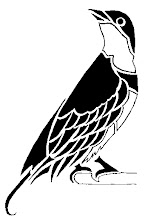
A modern version of the 19th century to early 20th century Arts and Crafts Movement is being created right now, in the US & Canada, and around the world. I think this is a good thing. I'd like to talk about it.
What is "arts and crafts"? In particular, is it the same as "art"? or "Art"? Many people seem to have been introduced to the concept of arts and crafts as children, in the form of elementary school participatory creativity, occasionally using grown-up, "official" artists' materials such as paintbrushes, pastels, or watercolors, but most often using household items that come to hand: milk and egg cartons, tin cans, string, yarn, paper plates, bits of fabric, clothespins, paper lunch bags, ... the list is almost endless, and I can associate each of these things with a particular "craft" project that we kids completed "in Art." If we had been grown-ups instead of children, we might have called what we were doing "folk art," and perhaps called the class we were taking to learn how to create it a "Folk Art Workshop" or "Craft Workshop." As it was, we mostly just called the class in which we did this sort of thing "Art," as in "Look what I made in Art today, Mom!"
But although many of us had the kind of childhood I just described, many other people out there were ahead of the curve. Just check out:
California College of Arts & Crafts, www.ccac-art.edu
Oregon College of Art and Craft, www.ocac.edu/#/about-ocac
Madras College of Arts and Crafts, affiliated to Madras University, 31, E.V.R. Periyar High Road, Periamet Park Town, Chennai - 600003 Tamil Nadu, phone: (44) 25610878
Basically, I have had to re-examine what I thought about art, workmanship, and the work that goes into creating things generally. One theme from my childhood that I recall is wanting very badly to be able to make things--many things, like shoes and cards and quiche and dolls and hats and necklaces and skateboards and stationery and radios--that were typically "manufactured" and "supplied" to one in exchange for money. Kids have no money (we never even got "allowances" in my family); I figure this was my main motivation. But I also remember being intensely irritated by commercial products, especially ones that involved or were made from plastic in any way. Plastic was not a natural material, and I knew it; anything made from it had been made by machine. Moreover, I knew that not all things were born wrapped in plastic. I knew that price tags were not a natural part of things, either. I ruthlessly removed any plastic wrapping and price tags from all our household and grocery items the minute they were brought inside. I was obsessed. I knew from books that cheese was not created sliced; I also knew that maple syrup did not contain anything but maple syrup, in real life. I knew that bread could be made from flour, water, and yeast, and that diglycerides and preservatives and whatever else was on the label of the plastic bag our bread came in were not really the basic bread ingredients that, say, Heidi's Grandfather would have used while baking bread on his hearth in the Alps. I didn't know how that bread might have been stored, but I knew it would never have been sold, most likely, and none of its life, certainly, was spent in plastic. Even the word "product" annoyed me, implying as it did a mechanized manufacturing process that was out of the direct control of human hands.
I don't think it was just me, although maybe I had a stronger reaction than some others do to our world that takes "manu-facture," literally "making by hand," and turns it into the Fordian exercise in disintegration of personality and work that it has become. At the very beginning of the modern age, before computers but not before the perversion of "manu-facturing," there lived many brave souls who faced the mechanized future with open eyes, and who tried to improve it. They relied chiefly upon the idea that there really are some things that machines cannot do; that human labor and artistry would eventually be required in order to create many desirable and civilized things that humans cannot really do without. They believed that art is based deep in our human gene pool, and is not a talent residing in the occasional super-artist, but rather a deep human urge and need that surfaces relentlessly with no dependence on the spark of genius. William Morris, for example, explains in his utopian story News from Nowhere that art and artistry are, in fact, the highest form of craftsmanship. If humans suffered through a kind of annihilation of their handiwork brought on by the use of machines, and survived the inevitable revolution that would follow in its wake and recapture leisure time for workers, they would naturally begin once again to create art--that is, to make "the work in hand... excellent of its kind," and finally to succumb to a natural "craving for beauty." Check out Katherine Tyrrell's wonderful blog to learn more about some aspects of William Morris' art: http://makingamark.blogspot.com/2007/07/flowers-in-art-william-morris-herbals.html You may also want to just check out Morris' wikipedia article to find out about his amazing erudition and savvy political and economic views.
